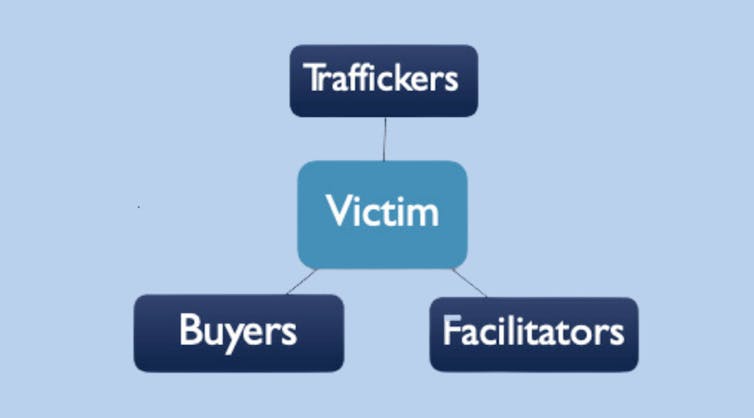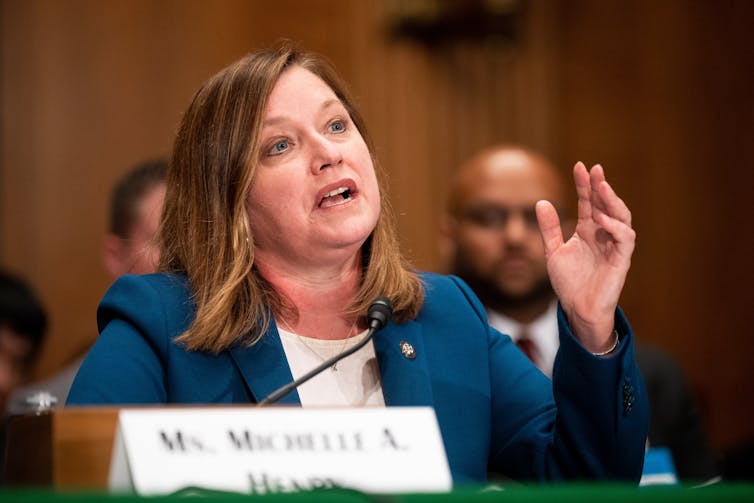I’m a former assistant district attorney who works with survivors of sex trafficking − here’s why a
The Pennsylvania attorney general’s investigation targeted not only the suspected leader of the trafficking ring, but also the alleged financial manager, drivers and customers.

Pennsylvania Attorney General Michelle Henry and the Pennsylvania State Police announced the arrests of 22 people connected to a long-standing, Philadelphia-based human trafficking ring on Oct. 22, 2024.
This investigation is the first of its kind in Pennsylvania. That’s because it targeted not only the suspected leader of the trafficking ring, but all prongs of the enterprise, including the alleged financial manager, drivers and customers, or “johns.”
I am the director of the Institute to Address Commercial Sexual Exploitation at Villanova University Charles Widger School of Law. Previously, I was an assistant district attorney in Philadelphia. In that role, I pioneered a program that encouraged a group of local, state and federal law enforcement agencies to collaboratively investigate and prosecute allegations of human trafficking in the city.
To date, investigations into sex trafficking in Pennsylvania have happened in silos. Law enforcement typically engages in stand-alone operations, or “prostitution stings,” that exclusively target either the demand or the supply – the sex buyers or sex sellers. Other operations solely target the traffickers.
While arresting buyers of sex is an effective way to reduce commercial sexual exploitation, it is only one piece of the puzzle. The traffickers and facilitators are another.
Targeting the supply is a more complex issue. Due to the overlap between people in prostitution and victims of trafficking, this often criminalizes – and further traumatizes and stigmatizes – trafficking victims.

Sex trafficking prevalent in Philadelphia
Both federal and Pennsylvania state law criminalize human trafficking. Human trafficking is defined as a crime of violence that occurs when an individual carries out a specific act, such as recruiting, enticing or soliciting, by a specific means, namely by force, fraud or coercion, for the purpose of commercial sex.
These comprehensive anti-trafficking laws criminalize a wide range of conduct and target a broad range of actors. But our analysis of data from the Administrative Office of Pennsylvania Courts shows that sex trafficking not only happens in the state, but that it happens at alarming rates, especially in the Philadelphia area.
Between 2014 and the end of 2023, prosecutors in 38 counties across Pennsylvania have charged 304 defendants with trafficking-related offenses.
Of those, 115 led to convictions and 43% occurred in or around Philadelphia.
In 2023, Philadelphia County had the most human trafficking convictions in the state at 19, followed by Delaware County with 11, Chester County with 10 and Bucks County with nine.
Arrest data sheds some light on the prevalence of trafficking in Philadelphia. But due to the illicit and underground nature of commercial sexual exploitation, which includes prostitution, it is difficult to study and quantify.
Targeting buyers and suppliers
Among those arrested on Oct. 22 are Terrance Jones, the alleged leader, his daughter, Natoria Jones, the alleged financial manager of the trafficking enterprise, four alleged drivers and 16 men who allegedly paid money for sex.
Terrance Jones and Thomas Reilly, one of Jones’ alleged drivers and his “trusted confidant,” were charged with trafficking in individuals and related charges, including involuntary servitude, promoting prostitution and patronizing prostitution.
The other alleged drivers were charged with promoting prostitution and related charges, and the alleged commercial sex buyers were charged with patronizing prostitutes and criminal conspiracy.
Economic market theory supports the concept that supply and distribution follow demand. Applying this theory to human trafficking leads to the conclusion that as long as there is a demand for commercial sex, there will be traffickers who exploit victims – primarily women, girls and LGBTQ+ people – to fulfill that demand.

Turning point?
I’d argue that Henry used Pennsylvania’s human trafficking statute as the legislature intended it to be used – to target all sectors that make money from trafficking, facilitate the trafficking organization and drive the market for it to exist in the first place.
That is precisely what makes this investigation unique. Law enforcement targeted all levels of the supply chain for commercial sex, uprooting the alleged trafficking ring from top to bottom. The leader, financial manager, drivers and buyers were all charged with multiple counts for their roles in allegedly exploiting the victims.
Moreover, the fact that none of the victims in this case was charged with prostitution is a recognition by the office of the attorney general that those who are exploited through sex trafficking are victims and should not be criminalized.
This recognition, coupled with the attorney general’s top-down approach, could signify an important turning point in investigative strategy in Pennsylvania and beyond – one I believe that can significantly reduce rates of human trafficking and commercial sexual exploitation in the state.
Riley Crouthamel, a research assistant at the Institute to Address Commercial Sexual Exploitation at Villanova University’s Charles Widger School of Law, contributed to this article.
Shea Rhodes receives funding from the Pennsylvania Commission on Crime and Delinquency.
Read These Next
As DOJ begins to release Epstein files, his many victims deserve more attention than the powerful me
Powerful men connected to Jeffrey Epstein are named, dissected and speculated about. The survivors,…
The world risks forgetting one of humanity’s greatest triumphs as polio nears global eradication − 7
Polio may finally be defeated in the next 5 years. Will the world recognize what an extraordinary achievement…
As millions of Americans face a steep rise in health insurance costs, lawmakers continue a century-l
US health care policy will remain fractured until lawmakers address the core question of who is responsible…






